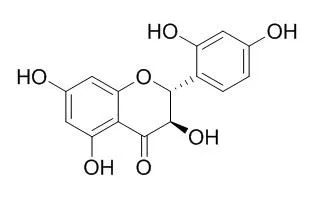| In vitro: |
| J. Funct. Foods, 2015,13:375-83. | | Oxyresveratrol and trans -dihydromorin from the twigs of Cudrania tricuspidata as hypopigmenting agents against melanogenesis[Reference: WebLink] | The depigmenting effects of oxyresveratrol and trans- Dihydromorin were investigated in b16F10 cell line and its synergetic melan-a cells, as well as in 3-dimensional skin models.
METHODS AND RESULTS:
But their inhibitory effects were different in two cell lines. In b16 cells, oxyresveratrol showed stronger depigmenting effect than trans- Dihydromorin, with greater suppression on tyrosinase activity. Both of them induced post-transcriptional degradations of microphthalmia-associated transcription factor (MITF), leading to significant decreases of tyrosinase related protein 1 (TRP-1) and tyrosinase related protein 2 (TRP-2) production. In melan-a cells, trans- Dihydromorin exhibited stronger inhibition on melanin synthesis. It also induced greater suppression on the levels of tyrosinase, TRP-1 and TRP-2 via MITF down-regulation at both transcription and translation level. Evaluations in artificial skin model also demonstrated the depigmenting effects of trans- Dihydromorin.
CONCLUSIONS:
In conclusion, we found that trans -Dihydromorin is an effective hypopigmenting agent in normal skin cells. Furthermore we demonstrated that hypopigmenting agents effective in melanoma system may not be effective on normal melanocytes, indicating that a non-tumor melanocyte system is more suitable for the screening of hypopigmenting agents. | | Mol. Nutr. Food Res., 2008,52(12):1530-8. | | Isolation of tyrosinase inhibitors from Artocarpus heterophyllus and use of its extract as antibrowning agent.[Pubmed: 18683821] | A new furanoflavone, 7-(2,4-dihydroxyphenyl)-4-hydroxy-2-(2-hydroxy propan-2-yl)-2, 3-dihydrofuro(3, 2-g)chromen-5-one (artocarpfuranol, 1), together with 14 known compounds, Dihydromorin (2), steppogenin (3), norartocarpetin (4), artocarpanone (5), artocarpesin (6), artocarpin (7), cycloartocarpin (8), cycloartocarpesin (9), artocarpetin (10), brosimone I (11), cudraflavone B (12), carpachromene (13), isoartocarpesin (14), and cyanomaclurin (15) were isolated from the wood of Artocarpus heterophyllus.
METHODS AND RESULTS:
Their structures were identified by interpretation of MS,( 1)H-NMR,( 13)C-NMR, HMQC, and HMBC spectroscopic data. Among them, compounds 1-6 and 14 showed strong mushroom tyrosinase inhibitory activity with IC(50) values lower than 50 microM, more potent than kojic acid (IC(50) = 71.6 microM), a well-known tyrosinase inhibitor. In addition, extract of A. heterophyllus was evaluated for its antibrowning effect on fresh-cut apple slices. It was discovered that fresh-cut apple slices treated by dipping in solution of 0.03 or 0.05% of A. heterophyllus extract with 0.5% ascorbic acid did not undergo any substantial browning reaction after storage at room temperature for 24 h. The antibrowning effect was significantly better than samples treated with the extract (0.03 or 0.05%) or ascorbic acid (0.5%) alone.
CONCLUSIONS:
The results provide preliminary evidence supporting the potential of this natural extract as antibrowning agent in food systems. |
|






 Cell. 2018 Jan 11;172(1-2):249-261.e12. doi: 10.1016/j.cell.2017.12.019.IF=36.216(2019)
Cell. 2018 Jan 11;172(1-2):249-261.e12. doi: 10.1016/j.cell.2017.12.019.IF=36.216(2019) Cell Metab. 2020 Mar 3;31(3):534-548.e5. doi: 10.1016/j.cmet.2020.01.002.IF=22.415(2019)
Cell Metab. 2020 Mar 3;31(3):534-548.e5. doi: 10.1016/j.cmet.2020.01.002.IF=22.415(2019) Mol Cell. 2017 Nov 16;68(4):673-685.e6. doi: 10.1016/j.molcel.2017.10.022.IF=14.548(2019)
Mol Cell. 2017 Nov 16;68(4):673-685.e6. doi: 10.1016/j.molcel.2017.10.022.IF=14.548(2019)